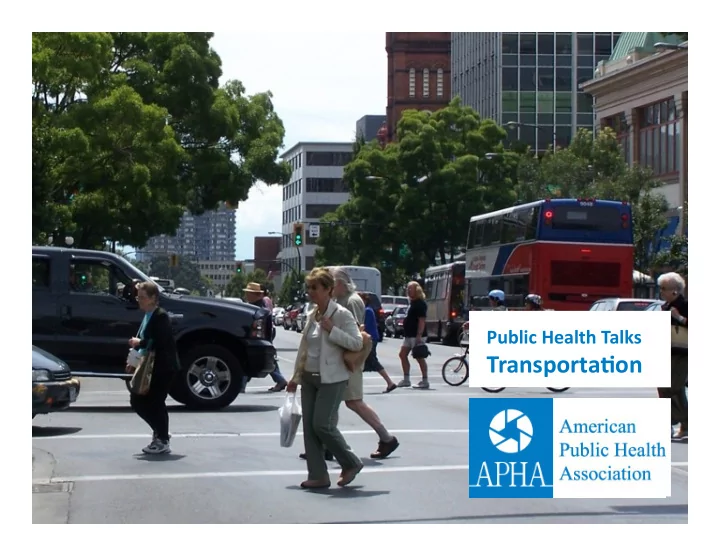

Public Health Talks Transporta4on 1
Why Public Health and Transporta4on? We all know transporta0on is a public health issue – Public safety – Air pollu0on – Physical ac0vity and obesity – Land use, built environment – Equity – Accessibility 2
The Challenge We all know transporta0on is a public health issue – Public safety – Air pollu0on – Physical ac0vity and obesity – Land use, built environment – Equity – Accessibility 3
The State of Play 4
Reaching An Audience Keep Texas Beautiful 5
Reaching An Audience Keep Texas Beautiful 6
Understanding Our Audience 7
Research Ques4ons How do transporta4on professionals think and/or talk about public health? How do the fields of public health and transporta4on communicate with each other? How can we improve the ways public health and transporta4on communicate with each other? 8
Research Methodology Review exis0ng transporta0on and public health communica0ons materials Media coverage of transporta0on debates Online survey focusing on transporta0on, planning, public health, advocacy – 769 responses! 20 one‐on‐one interviews with key representa0ves of: – Transporta0on – Public Health – Land Use 9
What impacts transporta4on? 10
Where’s health? And equity? 11
What impacts transporta4on planning? “Everybody wants to keep cars moving, sometimes to the detriment of people.” 12
What issues override public health? “Limited funding with “Domination by cars is many competing entrenched in planning. It's interests.” common for planners to say they’ll 'improve the roadways,' when all they’re doing is widening the road, which creates more barriers to other modes of transportation, forcing “Transportation planners’ more people into cars, and emphasis is on moving cars, not people.” creates a future need to widen the road.” 13
How does the transporta4on field view public health? “Mostly benign and somewhat naive and “As a separate uneducated about ‘the issue, not part of way things are…’” the core mission.” “As interlopers. I think that public health has a valuable message but is being pretty heavy-handed in pushing “Unrealistic.” their agenda and demanding things be done their way.” 14
Guiding Principles 15
Principle 1: Meet Them Where They Are 16
Meet Them Where They Are “Start with what resonates with departments of transportation. If we want to influence them, we have to tie this stuff back to what they care about. Say to them, if we can get people out of cars, it will help with your congestion problems, save your funding, etc. More people in cars equals a greater need for roads which eventually equals more money than you have to spend.” 17
Principle 2: Talk in Terms They Understand 18
Talk in Terms They Understand “The prevailing attitude is, cars pay for the road and everyone else is getting a free ride. It’s actually the opposite – pedestrians and cyclists save communities from having to pave more roads! It is far cheaper to build environments where people can walk and bike than to build one bigger intersection. We’d all be better off if we found a better way.” 19
Principle 3: Then Own Your Own Space 20
Then Own Your Own Space “The exploding cost of health care is showing if we don’t move toward preventive health (obesity, diabetes, lack of opportunities to exercise, levels of isolation as a result of sprawl and no public transportation), and build neighborhoods right, health care costs soar. Which makes all of our economy slow. We can’t afford not to have healthy people.” 21
Three Principles 1. Meet Them Where They Are 2. Talk in Terms They Understand 3. Then Own Your Own Space 22
Topline Messages 23
Meet Them Where They Are Providing more op4ons for geYng around helps to keep roads safe and in good shape . – It lets people take public transit, walk or bike, reducing traffic and decreasing roadway wear and tear . – More op0ons make it easier, more convenient and more affordable for everyone to get around – drivers , cyclists, transit riders and pedestrians. 24
Talk in Terms They Understand At every level, we need to be serious about how limited transporta0on dollars get spent. – America needs major infrastructure investment in the coming years. We’re expected to do a lot with li^le. – However, this also provides us with an opportunity to be crea0ve and think in new ways about how we design our transporta0on systems going forward. 25
Then Own Your Own Space (Pt 1) Giving people op0ons for geYng around is really an investment in health . – Trails for runners, bike lanes for commuters and sidewalks for a stroll to the store all provide opportuni0es to incorporate exercise into everyday life, comba0ng obesity while cuYng air pollu0on. – And a healthy community saves money – it makes good business sense to consider issues like obesity, diabetes, safety and air quality when we make transporta0on decisions. 26
Then Own Your Own Space (Pt 2) Make it local – [Specific transporta2on investment] is really an investment in preven0ve health care. It will make our community healthier, which isn’t just good policy today – it will reduce health care costs tomorrow. – [Specific transporta2on investment] will give people more op0ons to get around and lighten the pressure on household budgets. – [Specific transporta2on investment] would ease pressure on our streets and highways, which means fewer headaches and safer condi0ons for drivers on the road. – [Specific transporta2on investment] will make driving, riding, biking and walking all more convenient. 27
Final Thought 28
Free Materials For You Full talking points Customizable talking points Op‐Ed, Le^ers to the Editor “Cheat Sheet” of useful data Training presenta0ons on communica0ons skills Addi0onal APHA background materials Visit apha.org/transporta4on and click on the ‘Toolkit’ link 29
Thank You! Eloisa Raynault eloisa.raynault@apha.org | 202‐777‐2742 30
Recommend
More recommend